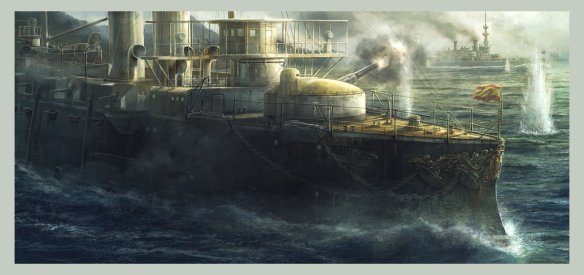The Biggest naval battle of Spanish-American war, called Battle of Santiago de Cuba. The whole war went very unfortunate for Spain and this was the end of the hundreds years old Spanish empire, it was year 1898.
Technical characteristics
Infanta Maria Teresa was built at Bilbao, northern Spain. She was laid down in 1889, launched on 30 August 1890, and completed in 1893. She had two funnels and was fast and well-armed. Her main armament was mounted on the center line in single barbettes fore and aft. Her armor was poor: her 11-inch guns had only lightly armored hoods, her 5.5-inch guns were mounted in the open on the upper deck, her armor belt was thin and protected only two-thirds of her length, and she had a high, unprotected freeboard that took much damage during the Battle of Santiago de Cuba. Like other nineteenth-century warships, she was heavily furnished and decorated with wood, which the Spanish failed to remove prior to combat and which would feed fires during the battle.
Operational history
Infanta Maria Theresa was flagship of Vice Admiral Pascual Cervera y Topete, commander of the Spanish Navy’s 1st Squadron, when tensions with the United States were rising after the explosion and sinking of the battleship USS Maine in the harbor at Havana, Cuba on 15 February 1898. The squadron concentrated at São Vicente in Portugal’s Cape Verde Islands; departing Cadiz on 8 April 1898 Infanta Maria Teresa, armored cruiser Cristóbal Colón, and three destroyers arrived at São Vicente on 14 April 1898, experiencing machinery problems and burning excessive amounts of coal during the voyage. As more ships arrived over the next few days, it was noted that the 5.5-inch guns aboard Infanta Maria Theresa had defective breach mechanisms and had been supplied with defective ammunition, and that the fleet had a shortage of stokers.
